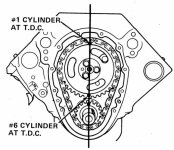Inert_Production
New member
I recently purchased my first boat, a 19' 87 Century with 260hp & alpha one. The owner said it sat for 5 years and needed a starter. After rebuilding the starter and the carburetor it started and idled OK, but as soon as any throttle was applied it would make a tapping noise. I pulled the valve covers and took a look at everything, nothing obvious was happening.. so I put it in the water thinking it was a sticky lifter and hoping it would come out of it. The noise got worse and the engine didn't have much power. Thinking it was something more severe, I pulled the engine and stripped it down to find out it had a spun lower rod bearing and the piston was smacking the head. After further investigation, most of the cylinders are scoured and other crank bearing surfaces are damaged. Sooo, time for rebuild. Now that I've assessed the damage this is what I'll need as a minimum to get the engine back up to par (reliability and fuel economy being most important).
This is what I have for block and head casting numbers:
block:
638
A10
627
L-15
H14
5
GM 57LG
SGT
E040
14093638
V0523uSC
CHE543495
HEAD:
1410219
E090
8
88
I'm having trouble finding the volume of the heads, but anyway this is what I need help on; deciding what components to get:
* Over sized piston kit with D-dish type for .038-.040 squish clearance
* Crankshaft
* Camshaft, timing chain, lifters, oil pump, etc.
* Manifolds and risers (they have been welded)
I plan on re-using the valves and springs.
So can anyone point me in the right direction for my first 350 marine engine build? I've done lots of snowmobile, jet ski, atv and dirtbike engines but nothing like this.
This is what I have for block and head casting numbers:
block:
638
A10
627
L-15
H14
5
GM 57LG
SGT
E040
14093638
V0523uSC
CHE543495
HEAD:
1410219
E090
8
88
I'm having trouble finding the volume of the heads, but anyway this is what I need help on; deciding what components to get:
* Over sized piston kit with D-dish type for .038-.040 squish clearance
* Crankshaft
* Camshaft, timing chain, lifters, oil pump, etc.
* Manifolds and risers (they have been welded)
I plan on re-using the valves and springs.
So can anyone point me in the right direction for my first 350 marine engine build? I've done lots of snowmobile, jet ski, atv and dirtbike engines but nothing like this.


